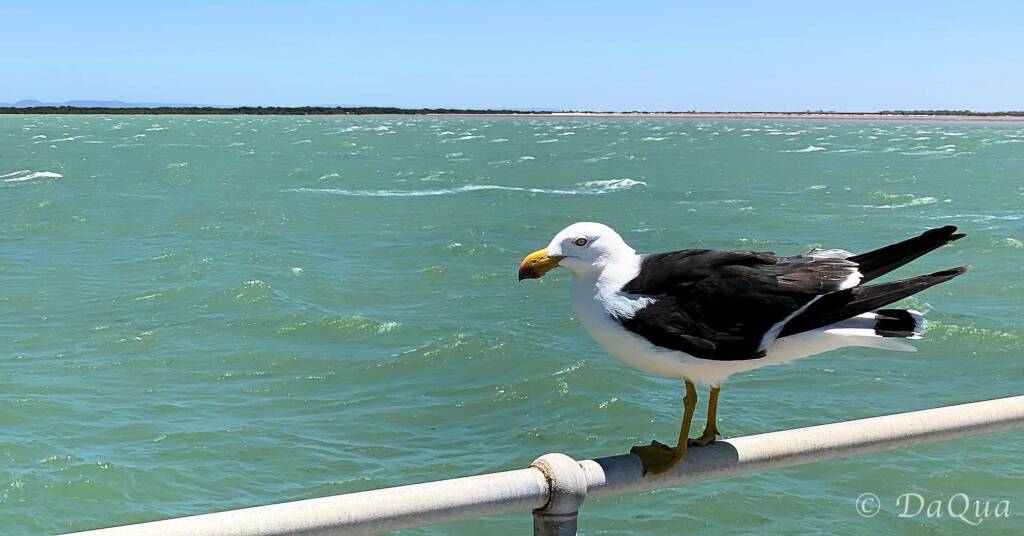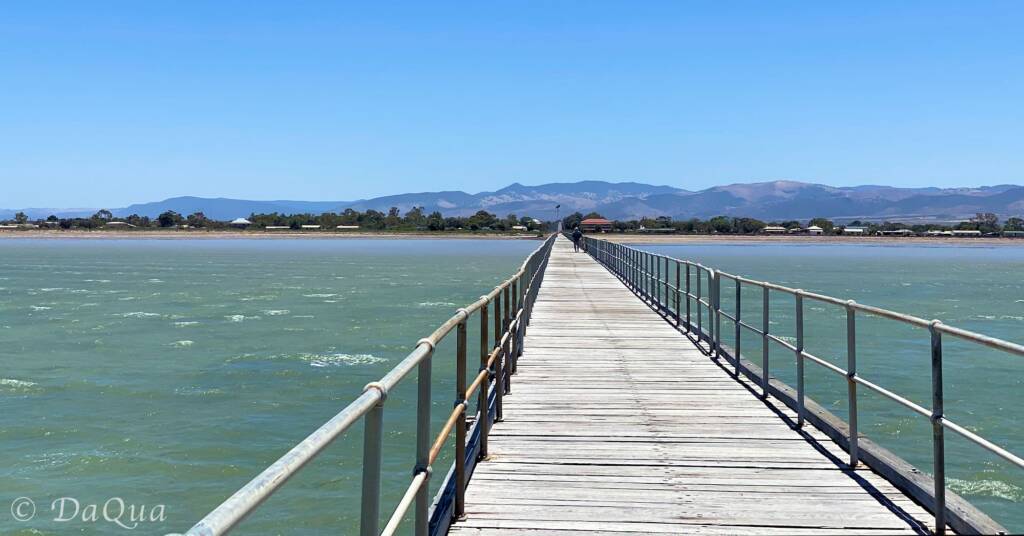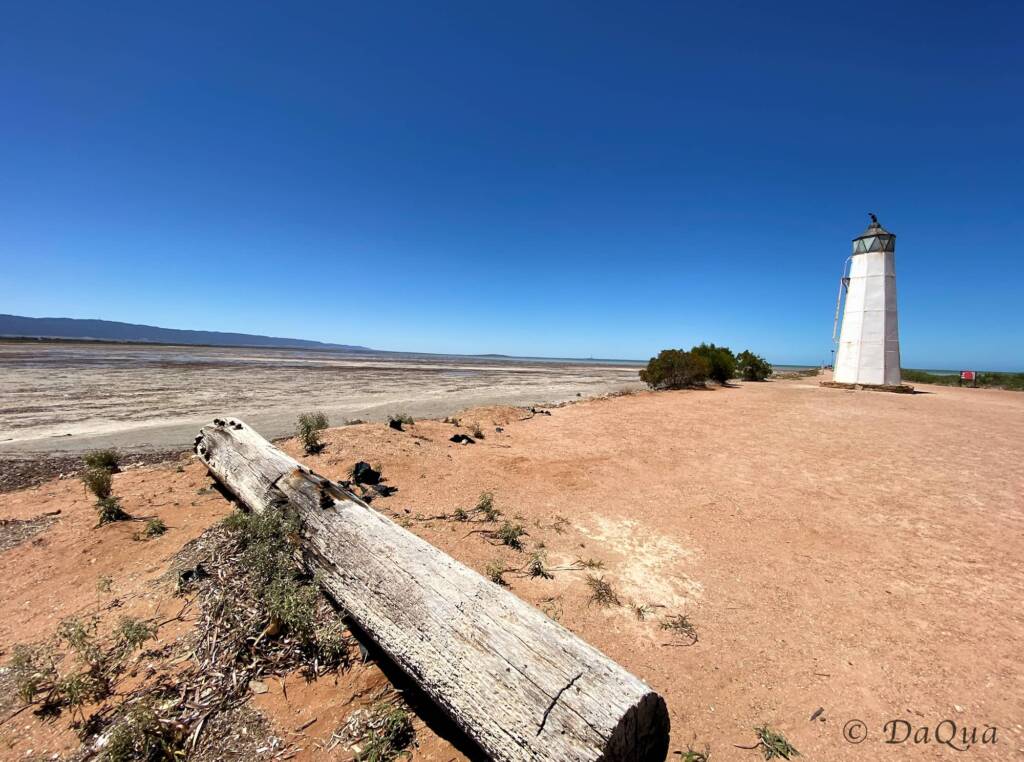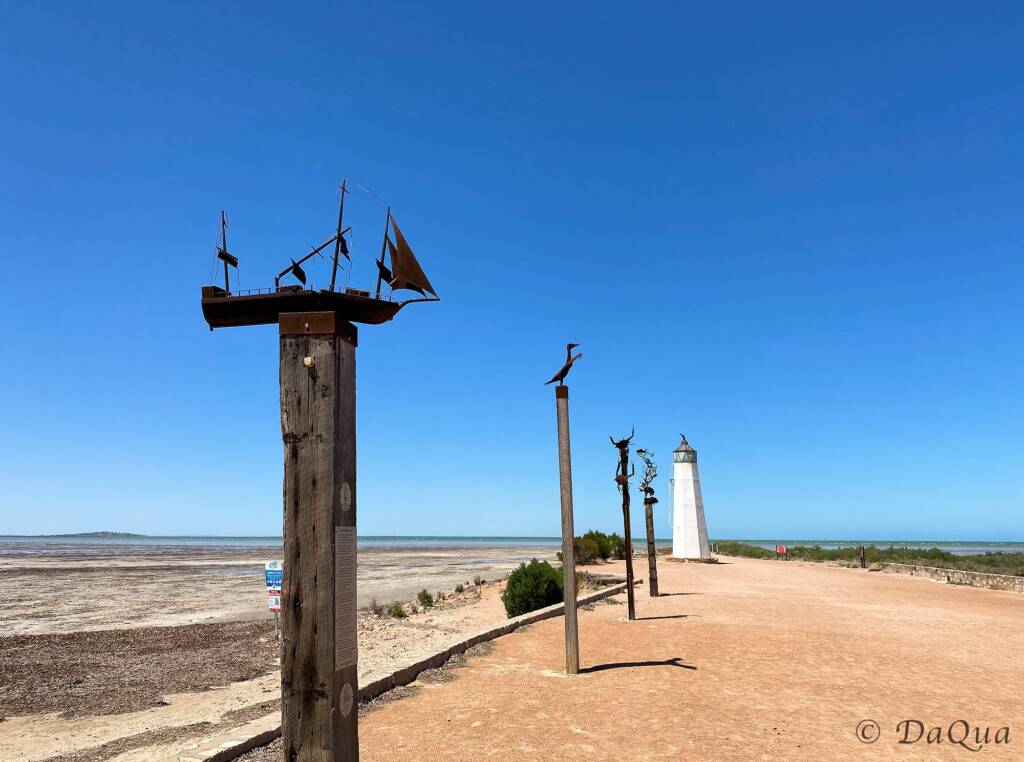Once an important transport hub servicing the surrounding districts, Port Germein today is a small sea-side town overlooking Germein Bay on the eastern side of Spencer Gulf in South Australia. It is only 19 km north of the city of Port Pirie and approximately 240 kms north of Adelaide.
When it opened its jetty in 1881, it was once the longest jetty in the Southern Hemisphere. Because of the shallow water along the coast, the long jetty allowed for sailing ships to be loaded from surrounding districts. At one point 100,000 bags of wheat were loaded per year. The jetty was to be extended to a length of 1,680 m in 1883. Wild seas and high tides have often battered the jetty, causing damage and reducing the length of the jetty to its current 1,532 metres. You can still see remnants of the old damaged part of the jetty, with the Flinders Ranges in the distance. The original jetty was built by John Wishart using local sugar and red gum trees.
This jetty, extending as it is over one and a half kilometres into the Spencer Gulf, is a popular heritage listed attraction, not only for locals and visitors, but the Silver and Pacific Gulls that are often just resting on the safety rail.

Listed on the South Australian Heritage Register, the Port Germein Jetty Site provides a great spot for fishing and swimming, the shallow waters allow walks from the beach or you can just descend from the jetty staircases along the jetty route.
Please note that the jetty is not shaded, so be prepared if walking the length with sunscreen, hat and drinking water.
Port Germein was formerly its own municipality (the District Council of Port Germein), it is now part of the District Council of Mount Remarkable since 1980.

Port Germein – The Story Behind the Name
This area of the Southern Flinders Ranges was first inhabited by the Nukunu Aboriginal People, their rich cultural heritage dates back over 60,000 years.The first European explorer to arrive was Captain Matthew Flinders in 1802. He named the waterway between the Yorke and Eyre Peninsula “Spencer Gulf”, Captain Nicholas Baudin followed soon after naming the bay “Golfe Bonaparte” for the French.
There is some argument as to how the port got its name. One source insists that Captain John Germein discovered the inlet during his exploration of the coast in 1840. Other sources claim that it was John’s brother, Samuel Germein, who discovered the inlet whilet taking stores to Edward Eyre at the head of Spencer Gult in 1840. One thing is certin, one member of the of the Germein family is honoured in the name of the town.
The first settlers felled valuable timber, created grazing and cropping lands and ultimately the grain trade. This led to the the development of Port Germein as a township and formal declaration as a port in 1841. It ws the largest greain shipping port in Australia. The region’s first District Council was established at Port Germein in 1888.
Windjammers filled their holds here and set off on the perilous journey home to Europe. The great “Grain Race” saw them competing to be first home in under 100 days. Four of the ships left port never to be seen again.
The town grew and prospered. Traders established hotels, ships chandlers and providores, banks bakeries, butchers, blacksmiths, carpentry shops, racetrack and brick works.
Services were established with a School, Churches, Public Services, Telegraph Station, Morgue, Institute Hall and Railway Station.
Gas street lights were used in the 1930s and 1940s.
Many of Port Germein’s streets were returned in 2013 to relfect its’s maritime heritage.
Source: Council street signage

The Lighthouse
The light house was erected at the end of the Port Germein Jetty in 1894. Up until then, a “Lightship” was anchored at it’s end that had a fixed light at each end. Two white sectors and one red. Visitors to Port Germein can still see the original lighthouse.
Lightships are floating lighthouses, placed where a permanent light was impossible to build at the time, acting as navigational aids and to warn ships of hazards.
The lighthouse was manned until 1917. It was then replaced with a flashing AGA light. (This system of lighting was the predominant form of light source used in lighthouses from the 1900s through to the 1960s. It was invented by Gustaf Dalén and marketed by his company AGA.)
In 1956 the light was severely damaged and ships that relied on it were now at severe risk when navigating the channel.
During its life time it was a bit of a “lovers lane” with many couples beginning their friendships in the lighthouse.
The lighthouse and the jetty retired at the same time, the jetty now a popular locals and tourist spot, with the lighthouse being relocated to its current position in 1975. It was restored in 2014.
Artwork
Along the shoreline at the beginning of the jetty are some wonderful sculptures — “sea creatures” — created by Port Pirie artist Max Newbery. The sculptures are of a shipwreck, cormorant, blue swimmer crabs and a fish and reef system. In the main BBQ area, opposite the caravan park, are mosaic artwork.

Images © DaQua
Footnote & References
- A Seaside Sojourn of Stories, by DaQua, 25 January, 2021
- An evening over the water at Port Germein By Dr Ann Jones on Off Track, ABC, www.abc.net.au/radionational/programs/offtrack/port-germein-jetty/6021166
- Walk the Longest Jetty in South Australia | Port Germein | Review, by Katrina Gogel, 7 September, 2019, Play & Go, Adeliade, www.playandgo.com.au/walk-the-longest-jetty-in-south-australia-port-germein-review/
- Port Germein History, by Louise, Adelaide, South Australia, www.portgermeinhistory.com
- Port Germein Lighthouse, Lighthouses of Australia Inc, https://lighthouses.org.au/sa/port-germein-lighthouse/
South AustraliaAdelaide Hills Alberrie Creek Algebuckina Bridge Belair National Park Kangaroo Island Kanku–Breakaways Conservation Park Mount Gambier Oodnadatta Oodnadatta Track Orroroo Port Augusta Port Germein Wabma Kadarbu Conservation Park William Creek Wilpena Pound Witjira National Park Woomera
